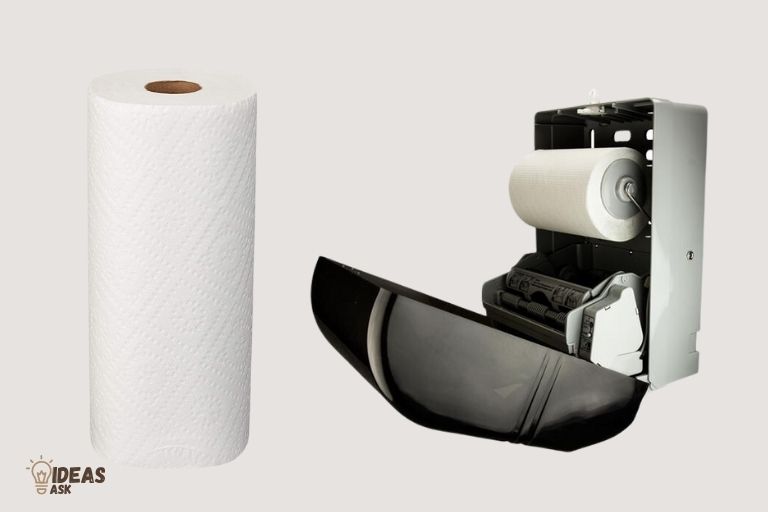How Do Automatic Paper Towel Dispensers Work? 7 Steps!
Automatic paper towel dispensers work through an infrared sensor technology.
When someone places their hand near the sensor, it detects the motion and triggers an internal mechanism that dispenses a predetermined length of paper towel.
The use of this automatic technology helps in maintaining hygiene as there is no contact with the dispenser.
The automatic paper towel dispenser operates on the principle of motion sensing. The infrared sensors detect the heat emitted from the user’s hand and trigger the dispensing mechanism.
A motor inside the dispenser then turns and rolls out the predetermined amount of paper towel. Once the hand is removed, the sensor stops the motor, halting the paper roll.
This technology is designed to provide convenience and promote sanitation.
Automatic paper towel dispensers are a remarkable blend of technology and convenience. Not only do they promote cleanliness and hygiene by reducing contact with surfaces, but they also provide ease of use with their motion sensor operation.
Furthermore, these dispensers can help to control waste by dispensing only a set amount of paper towel, contributing to environmental sustainability.
7 Steps for Using Automatic Paper Towel Dispensers
| Step | Explanation |
|---|---|
| 1 | Power Source: Automatic paper towel dispensers are battery powered or plugged into the wall. |
| 2 | Sensor Activation: The device employs infrared sensors to detect the presence of hands under the dispenser. |
| 3 | Signal Processing: When the sensor detects hands, it sends a signal to the dispensing mechanism. |
| 4 | Dispensing Towel: The dispenser releases a predetermined length of paper towel. |
| 5 | Cutting Mechanism: Some automatic dispensers incorporate an automatic cutting mechanism that separates the dispensed paper from the rest. |
| 6 | Delay Timer: After dispensing, the dispenser automatically goes to sleep for a few seconds before it can be activated again. This prevents unnecessary tissue wastage. |
| 7 | Refilling: When the paper roll runs out, the dispenser must be manually refilled with a new roll. |
Key Takeaway

Five Facts About Automatic Paper Towel Dispensers
An Introduction To How Automatic Paper Towel Dispensers Work
Automatic paper towel dispensers have become popular in public restrooms in recent years.
These dispensers offer a touch-free, hygienic solution to hand-drying, but have you ever wondered how they work?
We will introduce you to how automatic paper towel dispensers work.
Definition And Types Of Paper Towel Dispensers
Paper towel dispensers are used to hold and dispense paper towels for hand-drying purposes. They are commonly found in restrooms, kitchens, and other areas where hand-drying is necessary.
There are several types of paper towel dispensers, which include:
- Automatic paper towel dispensers
- Manual paper towel dispensers
- Center pull paper towel dispensers
- Folded paper towel dispensers
- Roll paper towel dispensers
Understanding The History And Evolution Of Automatic Dispensers
Automatic paper towel dispensers have been around for over 20 years. The first automatic dispenser was invented in the early 1990s and used infrared sensors to dispense paper towels.
Since then, automatic dispensers have evolved to become more advanced and efficient. The latest models feature advanced sensors that can detect hands from different angles and ensure that only one towel is dispensed at a time.
Why Choose Automatic Dispensers Over Manual Ones
There are many reasons why you should choose automatic paper towel dispensers over manual ones.
Here are some of the benefits:
- Hygiene: With automatic dispensers, there is no need to touch the dispenser to get a paper towel. This reduces the risk of contamination and helps to maintain good hygiene standards.
- Efficiency: Automatic dispensers dispense only one towel at a time, which helps to reduce wastage and saves money.
- Convenience: Automatic dispensers are easy to use and require no effort to operate. They are perfect for use in public restrooms where people are in a hurry.
- Environmentally friendly: Automatic dispensers help to reduce paper towel usage and therefore have a positive impact on the environment.
Automatic paper towel dispensers offer a touch-free, hygienic solution to hand-drying, making them a popular choice in public restrooms.
They have evolved over the years to become more advanced and efficient, and offer several benefits over manual dispensers.
Mechanical Components Of Automatic Paper Towel Dispensers
Automatic paper towel dispensers are becoming increasingly popular in public restrooms and commercial kitchens. They are convenient, efficient and, most importantly, hygienic. But have you ever wondered how they work?
Let’s delve into the mechanical components of automatic paper towel dispensers to understand their functionality.
The Sensor And Its Functionality
The sensor is the key component that enables an automatic paper towel dispenser to detect the presence of a user’s hand and dispense a paper towel automatically.
Here are some key points about the sensor and its functionality:
- The sensor emits an infrared signal to detect the presence of a user’s hand.
- The signal reflects back to the sensor, which triggers the dispenser to dispense a paper towel.
- The sensor’s sensitivity can be adjusted to prevent wastage of paper towels.
- The sensor requires a power source to function.
The Motor And Its Functions
The motor is responsible for dispensing the paper towel once the sensor has detected the user’s hand.
Here are some key points about the motor and its functions:
- The motor is activated by the sensor once a user’s hand is detected.
- The motor rotates the roller, which leads to dispensing of the paper towel.
- The speed of the motor determines the length of the paper towel dispensed.
- The motor requires a power source to function.
The Gear System And Its Importance
The gear system enables the motor to rotate the roller and dispense the paper towel.
Here are some key points about the gear system and its importance:
- The gear system consists of a set of gears that transmit the motor’s rotation to the roller.
- The gear system determines the speed and accuracy of the paper towel dispensing process.
- The gear system is designed to prevent jamming of the dispenser.
- The gear system requires periodic maintenance to ensure proper functioning.
The Battery And Power Supply
The automatic paper towel dispenser is powered either by batteries or a direct power supply.
Here are some key points about the battery and power supply:
- The battery-powered dispenser uses batteries to operate the motor and the sensor.
- The battery life depends on the frequency of usage and the quality of the batteries.
- The direct power supply dispenser is connected to a power source to operate the motor and the sensor.
- The direct power supply dispenser is more cost-effective in the long run than the battery-powered dispenser.
Understanding the mechanical components of automatic paper towel dispensers can help us appreciate their convenience and efficiency.
The sensor, motor, gear system, battery and power supply all play a crucial role in dispensing paper towels hygienically and efficiently.
How Do Automatic Paper Towel Dispensers Detect Hands
The Science Behind Sensor Detection
The automatic paper towel dispenser is a device that is designed to deliver paper towels to the user without any manual input.
The device is equipped with a sensor that detects the presence of a person’s hand beneath the dispenser.
This sensor works by emitting an infrared signal, which bounces off the object and then returns to the sensor. When a hand is detected, the dispenser releases a pre-set amount of paper towel for the user to take.
The Different Technologies Used For Sensing
There are different technologies used for sensing in automatic paper towel dispensers. Some of the commonly used technologies include infrared sensors, ultrasonic sensors, and capacitive sensors.
Infrared sensors emit a beam of infrared radiation, which is then reflected back by the object, and sensed by the sensor.
Ultrasonic sensors work by emitting high-frequency sound waves, which are then reflected back by the object, and sensed by the sensor. Capacitive sensors work by detecting changes in an electric field caused by the presence of an object.
The Advantages And Disadvantages Of Different Sensing Technologies
Each type of sensing technology has its own advantages and disadvantages.
Here are some of the most common:
Infrared Sensors
- Advantages: Accurate detection, long-lasting, and low power consumption.
- Disadvantages: Can be affected by environmental factors such as sunlight, dust, and humidity.
Ultrasonic Sensors
- Advantages: Good at detecting soft or non-metallic objects, and can work in harsh environments.
- Disadvantages: Can use up a lot of power, and can have difficulty detecting small objects.
Capacitive Sensors
- Advantages: Can detect a wide range of materials, including liquids and powders.
- Disadvantages: Can be affected by environmental factors such as moisture, and can have difficulty detecting small or non-conductive objects.
Overall, the technology used for sensing in an automatic paper towel dispenser will depend on the specific application, environment, and user requirements.
The Dispensing Mechanism Of Automatic Paper Towel Dispensers
Automatic paper towel dispensers are commonly used in public restrooms, commercial kitchens, hospitals, and other facilities.
They can quickly and easily dispense paper towels without the need for physical contact, providing a more hygienic solution.
We’ll discuss how these dispensers work, focusing on the dispensing mechanism.
The Role Of Motors And Gears In Dispensing Paper Towels
Automatic paper towel dispensers use an electric motor and a series of gears to control the dispensing of paper towels.
Here’s how it works:
- When a user places their hand under the dispenser, an infrared sensor detects their presence and signals the motor to begin spinning.
- As the motor turns, it engages with a series of gears that work together to pull the paper towel forward from the roll.
- Once the desired length of paper towel has been dispensed, the motor stops spinning and the gears disengage.
- The paper towel is then torn off from the roll using a built-in cutting mechanism and presented to the user, all without them having to touch any part of the dispenser.
Understanding The Mechanism Of Cutting Paper Towels
The cutting mechanism is an essential component of the automatic paper towel dispenser.
Here’s how it works:
- The cutting mechanism uses a serrated blade that cuts the paper towel off from the roll when it has been dispensed.
- The blade is positioned just above a curved plate that acts as a countertop.
- As the paper towel is dispensed, it comes into contact with the curved plate, which creates a natural break in the paper towel.
- The serrated blade then cuts through the weakened section, allowing the user to tear off the desired length of paper towel.
What Happens When Dispensing Goes Wrong?
While automatic paper towel dispensers are generally reliable, occasionally, things can go wrong.
Here are a few issues that can arise:
- The dispenser may fail to detect the user’s presence due to a malfunctioning sensor.
- The motor or gears may become jammed, preventing the dispensing of paper towels.
- The cutting mechanism may be dull or misaligned, resulting in uneven or incomplete cuts.
In such cases, users may need to seek assistance from a maintenance professional or facility manager to resolve the issue.
Automatic paper towel dispensers utilize motors, gears, and a cutting mechanism to deliver a hygienic and convenient solution for dispensing paper towels.
By understanding how they work, users can make the most of these devices and troubleshoot issues as needed.
FAQ On Automatic Paper Towel Dispensers
How Do Automatic Paper Towel Dispensers Work?
Automatic paper towel dispensers work by using sensors to detect motion and dispense a specific amount of paper.
Are Automatic Paper Towel Dispensers More Hygienic?
Yes, automatic paper towel dispensers are more hygienic since users do not need to touch the dispenser to get the paper.
How Do You Change The Paper In An Automatic Paper Towel Dispenser?
To change the paper in an automatic paper towel dispenser, open the dispenser, remove the empty roll and replace it with a new one.
Can Automatic Paper Towel Dispensers Save Money?
Yes, automatic paper towel dispensers can save money by dispensing a specific amount of paper, reducing waste and minimizing the need for refills.
Conclusion
The convenience of automatic paper towel dispensers is undeniable. These devices use advanced technology to dispense paper towels without any physical contact, providing a more hygienic and time-saving experience compared to manual dispensers.
The sensors inside the dispenser detect the presence of hands, automatically release the towel, and cut it to the desired size.
Different types of dispensers use different methods to supply, dispense, and cut paper towels. Some use batteries or plug-ins to power their sensors, while others rely on hand-cranking.
Understanding how automatic paper towel dispensers work is essential for maintaining and troubleshooting them. It is also crucial to regularly clean and refill them to ensure their smooth operation.
With their many benefits and ease of use, automatic paper towel dispensers are becoming increasingly popular in various commercial settings, such as public restrooms, hospitals, and restaurants.




